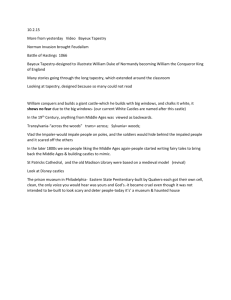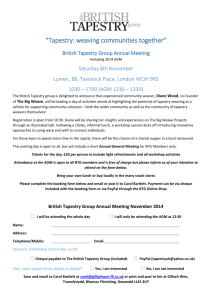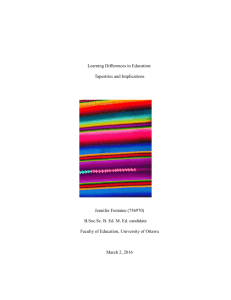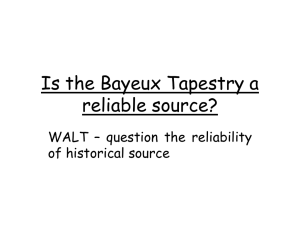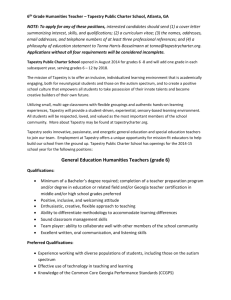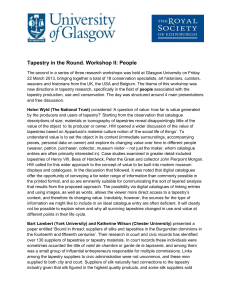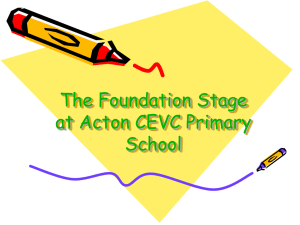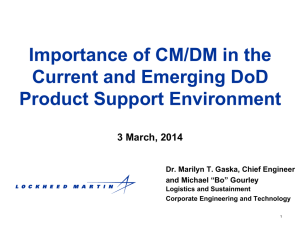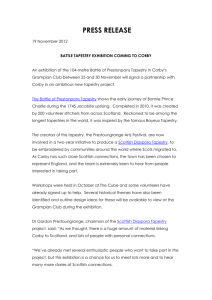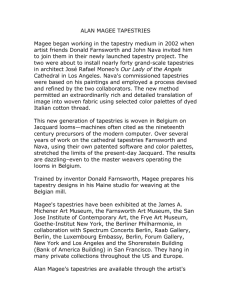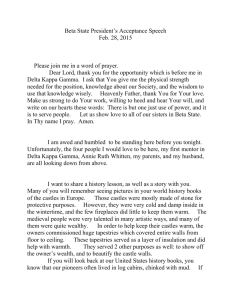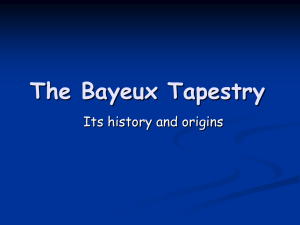Techniques. September 2013, The Dovecot Studios
advertisement
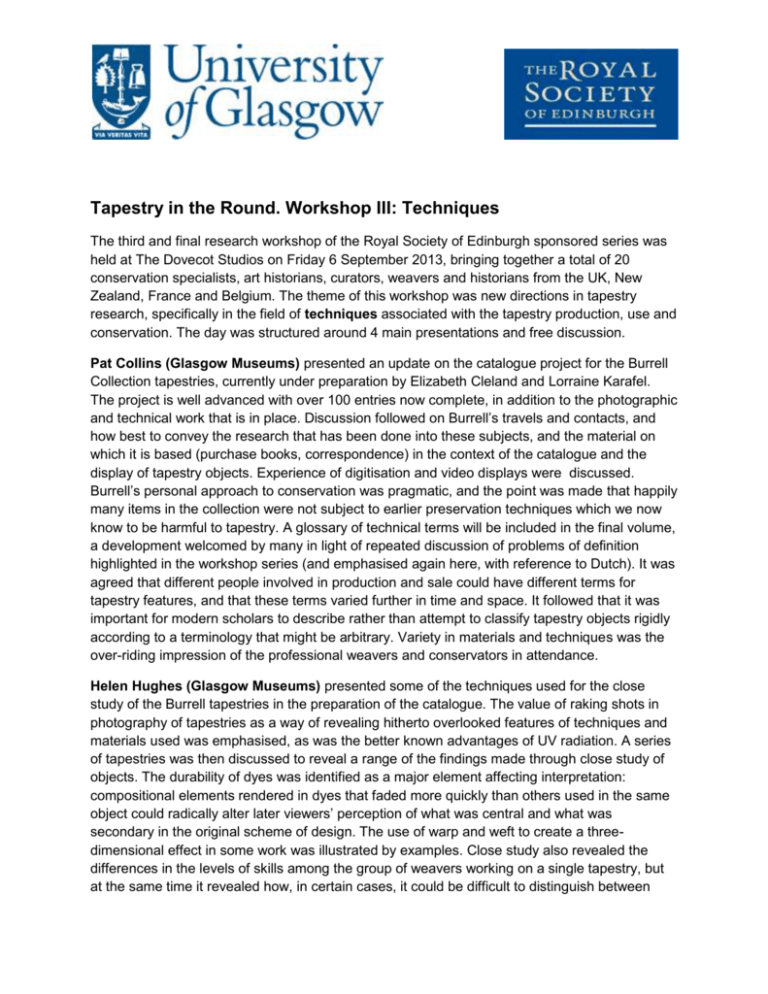
Tapestry in the Round. Workshop III: Techniques The third and final research workshop of the Royal Society of Edinburgh sponsored series was held at The Dovecot Studios on Friday 6 September 2013, bringing together a total of 20 conservation specialists, art historians, curators, weavers and historians from the UK, New Zealand, France and Belgium. The theme of this workshop was new directions in tapestry research, specifically in the field of techniques associated with the tapestry production, use and conservation. The day was structured around 4 main presentations and free discussion. Pat Collins (Glasgow Museums) presented an update on the catalogue project for the Burrell Collection tapestries, currently under preparation by Elizabeth Cleland and Lorraine Karafel. The project is well advanced with over 100 entries now complete, in addition to the photographic and technical work that is in place. Discussion followed on Burrell’s travels and contacts, and how best to convey the research that has been done into these subjects, and the material on which it is based (purchase books, correspondence) in the context of the catalogue and the display of tapestry objects. Experience of digitisation and video displays were discussed. Burrell’s personal approach to conservation was pragmatic, and the point was made that happily many items in the collection were not subject to earlier preservation techniques which we now know to be harmful to tapestry. A glossary of technical terms will be included in the final volume, a development welcomed by many in light of repeated discussion of problems of definition highlighted in the workshop series (and emphasised again here, with reference to Dutch). It was agreed that different people involved in production and sale could have different terms for tapestry features, and that these terms varied further in time and space. It followed that it was important for modern scholars to describe rather than attempt to classify tapestry objects rigidly according to a terminology that might be arbitrary. Variety in materials and techniques was the over-riding impression of the professional weavers and conservators in attendance. Helen Hughes (Glasgow Museums) presented some of the techniques used for the close study of the Burrell tapestries in the preparation of the catalogue. The value of raking shots in photography of tapestries as a way of revealing hitherto overlooked features of techniques and materials used was emphasised, as was the better known advantages of UV radiation. A series of tapestries was then discussed to reveal a range of the findings made through close study of objects. The durability of dyes was identified as a major element affecting interpretation: compositional elements rendered in dyes that faded more quickly than others used in the same object could radically alter later viewers’ perception of what was central and what was secondary in the original scheme of design. The use of warp and weft to create a threedimensional effect in some work was illustrated by examples. Close study also revealed the differences in the levels of skills among the group of weavers working on a single tapestry, but at the same time it revealed how, in certain cases, it could be difficult to distinguish between original weaving at the point of fabrication, and later re-weaving as a result of repair. It was agreed that while there were obvious points in a tapestry’s history that re-weaving might occur (eg for sale), in reality many tapestries had a history of re-weaving which recurred more or less frequently through repair throughout the social life of the object. Pascal Bertrand (University Michel de Montaigne – Bordeaux 3) gave his presentation on the Aubusson tapestries (18th century), drawing on the account books of Pierre and Gabriel Picon. At this point tapestry production had to compete with a greater and more impressive range of wall coverings (panelling, wallpaper, mirrors) than ever before: what techniques of sale could be used to maintain a market, especially when that market commonly lay far away from the large urban centres in rural manors and castles? Study of the account books reveals how family networks of merchants (the Picons, the Jaucourts) spread their business and therefore their risks. Manufacturers like Aubusson diversified production for different markets for tapestry (with a clear classification of different qualities of tapestry) and tapestry products (notably furniture production). Variety was the key. Diversification could lead some individuals such as the weaver Desartaux to take on multiple roles, from production to sale. Single sales, especially, of high value items, could involve a large number of individuals: the purchaser and his or her agent, the banker, the entrepreneur, the subcontractor and the many lesser figures involved in production. Lesser quality tapestry goods could be sold with success to less sophisticated markets. The account books of Picon reveal ownership of 10-15 looms, their sub-contracting to 100 or more weavers living nearby, and a sales network that included Madrid, Basel, Milan, Zurich and North America, all from a Parisian base. Discussion revealed similar documentation surviving for Antwerp production. In the final session participants divided into four groups to discuss the day’s findings and summarise. Among the topics that arose were the following: - How production techniques added value to materials used The large number of decisions made by single weavers in the course of production, and how these can be identified and assessed How technique might be varied to achieve different effects for similar subject matter, eg male and female faces. The need for continuing work on dye analysis and more work on fleece analysis. Discussion of the relative impact of mordants and dyes. The challenges of explaining techniques of production to modern audiences. Jonathan Cleaver (The Dovecot Studios) led a tour of the weaving floor of the Dovecot Studios for workshop participants, and conducted a visit of the exhibition ‘Fleece to Fibre: the making of the Large Tree Group Tapestry’. List of participants Kara Alen (Leuven University) Jenny Band (Westonbirt House), Pascal Bertrand (Bordeaux University), Tarn Brown (Glasgow Museums), Iain Buchanan (Auckland University), Jonathan Cleaver (Dovecot Studios), Pat Collins (Glasgow Museums), Maggie Dobbie (Glasgow Museums), Lesley Fraser (Edinburgh University), Kathryn Hallett (Historic Royal Palaces), Vivien Hamilton (Glasgow Museums), Maria Hayward (Southampton University), Helen Murdina Hughes (Glasgow Museums), Frances Lennard (Glasgow University), Ksynia Marko (The National Trust), Jamie Mulherron (Independent scholar), Anita Quye (Glasgow University), Graeme Small (Durham University), Katherine Wilson (Chester University).
